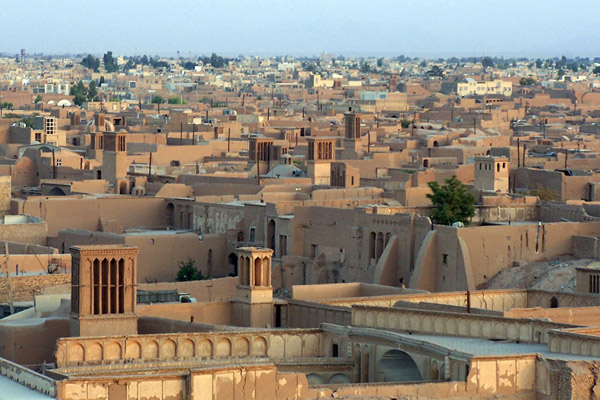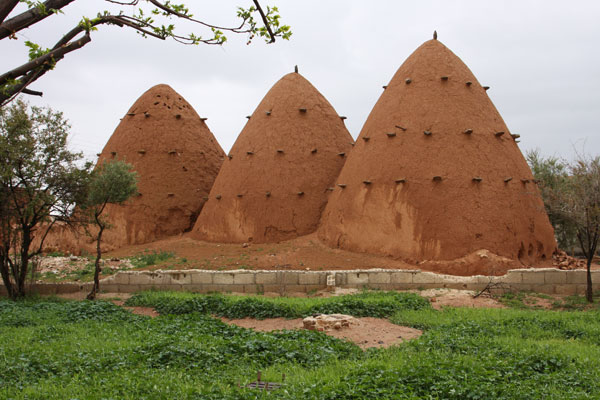Buildings and Architecture in Middle East
1 2
Durrat Al Bahrain is one of those man-made islands with luxury homes the Gulf countries are so famous for. Though not as grand as Palm Islands (not completed) or The World (far from completed) in Dubai or Pearl Qatar (not completed) in Qatar, Durrat Al Bahrain is still one of those crazy megaprojects, which are only feasible due to oil money. Unfortunately, the island is closed off for the public, so unless you know someone who lives there, you won't be let through the security gate on the mainland – we didn't.
There are few sites of historical relevance in the Gulf region. Instead, icons of modernity erupt from the desert sands. The Emirates has its Burj Khalifa. Kuwait has its Kuwait Towers. For Bahrain, its iconic building is the World Trade Centre. Marketed as the country's first SMART building, the symbiotic 50-storey towers (240 m) boast a fully integrated IT infrastructure. But beyond that, its the expansive views, business facilities and high-end shopping and dining options that are the attraction for most visitors. Frankly, the Centre's space age appearance is probably what most people will remember most. In a country lacking in major attractions, the WTC in Manama would have to qualify as a highlight.
Yazd's old quarters are just one of those fine travel surprises, which you probably hardly have heard about (until now). It's among one of the oldest towns in the world and the beautiful old city is still inhabited. A maze of narrow passageways between the adobe houses will get you lost in no time. Most houses are topped of with a so called windcatcher or badger, that is an ancient air-con system. The city was a major stop on the ancient silk route and Marco Polo passed through at some time.
The most impressive crusader castle in Jordan. It was build by the crusaders in mid 12th-century to control the trade route from Damascus to Mecca and Egypt. Forty years later it felt into the hands of the Muslim army lead by Saladin after a remarkable siege where the castle got bombarded by catapults from the hill opposite. In mid 13th-century it was taken over by Mamluks who added to the fortified castle. As with many other crusader leftovers it's a mix of style and architecture created over several centuries, which you can still differentiate today.
In contrary to other oil state metropols like Dubai and Abu Dhabi, Doha is still in the developing phase, and probably will be for many years to come. The center is a mix of brand new exotic looking skyscrapers and dusty construction sites, sprinkled with equal dusty empty lots. Since 2000 more than 30 skyscraper taller than 100 m have been erected, though some are not yet completed. The tallest will be Qatar National Bank Tower with 510 m (114 stories) when it completes. It seems that any concept can be realized, leaving the skyline of Doha, even as today, as a quirky mismatch of wonderful architecture among glass monsters, which can only have been created by people with too much business on their minds.
Ad Diriyah is the original hometown of Saudi royal family and was the first capital of the Saudi Dynasty. Today the town is located in the outskirts of modern Riyadh.
One historical district of Ad Diriyah is Al Turaif, which overlooks the oasis and palm gardens of Wadi Hanifa. The mud-brick ruins have made Al Turaif a UNESCO World Heritage site. There are remains of historic palaces, a mosque and other buildings. The restoration started in 2011 and is still on-going, but the whole area will transform into a large open air museum.
One historical district of Ad Diriyah is Al Turaif, which overlooks the oasis and palm gardens of Wadi Hanifa. The mud-brick ruins have made Al Turaif a UNESCO World Heritage site. There are remains of historic palaces, a mosque and other buildings. The restoration started in 2011 and is still on-going, but the whole area will transform into a large open air museum.
Taif's traditional souq is a pleasant surprise. It has been renovated tastefully and is still divided into areas for gold, perfumes, abayas (black cloak for women), etc. The maze of small squares and narrow lanes are only for pedestrians, so powershoppers hire a carrier with a wheelbarrow to transport their goods. In the evening the souq gets filled with locals, making it a great place for people watching.
These adobe huts do look like something from deep Africa. In ancient times, they were used as housing, but today they are merely storeroom and chicken shelters. A few villagers outside Hama still have them clustered next to their more ordinary houses. You have to trespass their courtyard to get a closer look, and it seems at bit random whether the people want to show them to you. Some want a bit of money, but most villagers are friendly and just watchful for their vegetables, making sure you are not stepping on them. You can see the houses on the road from Al-Hamra village to Qasr ibn Warden, a small ruin of a Byzantine sandstone palace in the middle of the plain.
Burj Khalifa is ridiculously tall, 828 m (plus a small tip) to be more precise, making it the tallest building in world. It's so tall that every other building in Dubai, even other super-tall skyscrapers, look tiny compared to this sleek shiny tower which seems to disappear into the sky. From the air the tower looks like a symmetric Y, a design apparently inspired from a lily, but from the ground it resembles an elegant sci-fi rocket. The 163 floors - where the top one is at 621 m - are used for both corporations, residences and hotels. Yes, here you can stay in an Armani suite. At first, during the construction, it was called Burj Dubai, but when completed it changed name to Burj Khalifa, probably in honor of Sheikh Khalifa, emir of Abu Dhabi, as he bailed out the project when it was badly needed.
The UNESCO list "Old Walled City of Shibam" is quite possibly the architectural highlight of Yemen. The 16th century fortified town is renowned for it's mud-brick skyscrapers, earning it the nickname "Manhattan of the Desert". One would assume that such a magnificent site would be inundated with tourists. But instead, due to difficulties getting there and a number of reported attacks on tourists, the site is all but deserted. All tourists must be accompanied by a (free) armed escort at all times when outside their hotel. This makes it a little difficult to mix with the generally friendly locals. But sitting on the hill as the last beams of sun reflect off the ancient town make it all worth while.
1 2












